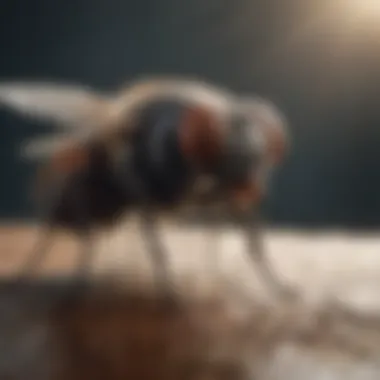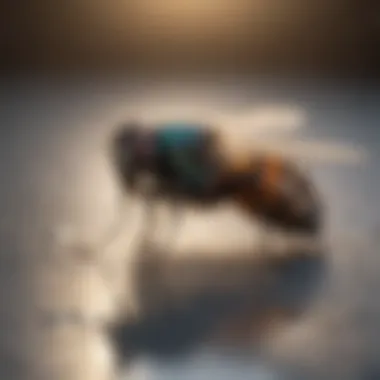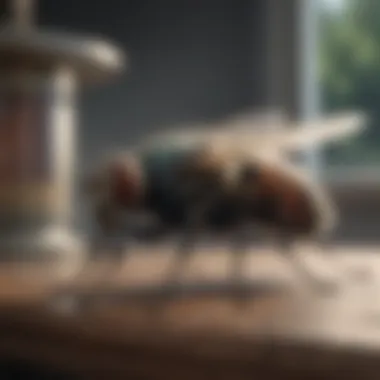Effective Ways to Eliminate Flies Indoors: A Comprehensive Guide


Preventive Pest Control Strategies
When it comes to preventing pesky flies from invading your living space, implementing effective preventive pest control strategies is paramount. Starting with House Exterior Protection, sealing cracks in your home's foundation and walls is crucial to blocking potential entry points for flies. Clearing debris around your property also eliminates breeding grounds for pests. Additionally, taking measures to prevent pests from entering, such as installing screens on windows and doors, reinforces your defense against flying invaders.
In terms of Yard Maintenance, maintaining essential yard care routines like regular mowing and trimming vegetation can significantly reduce habitats for pests. By keeping your yard well-manicured and free of debris, you create a less attractive environment for flies to thrive. Implementing methods like applying pest-repelling plants or natural insecticides can further deter pest infestations.
On the front of Indoor Cleanliness, expert cleaning tips and techniques play a pivotal role in deterring flies from infesting your home. Regularly vacuuming, sanitizing surfaces, and decluttering spaces not only improve overall hygiene but also remove potential food sources that attract flies. Creating a pest-resistant indoor environment through proper storage of food items and regular disposal of organic waste helps to mitigate the risk of fly infestations.
Efficient Garbage Disposal methods are crucial in preventing flies from being drawn to your home. Properly sealing garbage bins, disposing of trash promptly, and cleaning bins regularly are essential steps in keeping flies at bay. Understanding the importance of proper garbage disposal not only promotes hygiene but also discourages pests from congregating around your living area.
To complement these measures, adopting Other Pest Prevention Strategies, such as setting up physical barriers like door sweeps and caulking gaps in walls, provides additional layers of protection against unwanted intruders. Innovating ways to safeguard your home, such as using ultrasonic pest repellers or introducing natural predators of flies to the environment can further enhance your pest control efforts.
Understanding the Fly Infestation Issue
Identifying Fly Species
Distinguishing characteristics of common fly species
One of the critical aspects of combatting fly infestations is identifying the distinguishing characteristics of common fly species. By recognizing key features specific to each type of fly, individuals can tailor their control methods accordingly. For instance, houseflies are characterized by their small size, bristle-covered bodies, and mechanical transmission of diseases. Understanding these unique characteristics empowers homeowners to implement targeted control measures, such as utilizing fly traps or implementing preventive sanitation practices to deter housefly infestations.
Understanding the behavior patterns of different fly species
Understanding the behavior patterns of various fly species is vital in effectively eradicating fly infestations. Different fly species exhibit diverse behaviors, such as preferred breeding grounds, feeding habits, and seasonal activity. For instance, fruit flies are attracted to decaying organic matter, while drain flies breed in damp environments. By grasping these behavior patterns, individuals can proactively tackle fly infestations by eliminating breeding sites, implementing fly repellents, and reducing attractants specific to each fly species.
Assessing the Scope of Infestation
Identifying areas with the highest fly activity
To address fly infestations effectively, identifying areas with the highest fly activity is crucial. Common fly hotspots include trash cans, food storage areas, and moisture-rich spots like sinks and drains. By pinpointing these high-activity zones, homeowners can focus their control efforts on these areas, implementing targeted sanitation measures, and deploying fly traps to reduce fly populations effectively.
Evaluating potential breeding grounds


Evaluating potential breeding grounds is essential in eradicating fly infestations at the source. Identifying areas where flies are likely to breed, such as organic waste piles, decaying food residues, and stagnant water pools, allows individuals to disrupt the fly life cycle effectively. By eliminating these breeding grounds through proper waste management, regular cleaning, and drainage maintenance, homeowners can significantly reduce fly populations and prevent future infestations.
Implementing Preventive Measures
When it comes to effectively eliminating flies indoors, implementing preventive measures plays a crucial role in creating a fly-free environment. By proactively addressing potential fly infestations, you can significantly reduce the likelihood of these pests taking over your living space. Preventive measures not only tackle existing fly problems but also serve as a long-term solution to prevent future infestations.
Implementing preventive measures encompasses various specific elements that target different aspects of fly control. From maintaining cleanliness to sealing entry points and minimizing food sources, each component plays a key role in eradicating flies from your home. By focusing on preventive measures, you are taking a proactive approach to tackle the root cause of fly problems, setting the foundation for a pest-free household.
One of the primary benefits of implementing preventive measures is the reduction of health risks associated with flies. Flies are known carriers of diseases and can contaminate food and surfaces, posing a threat to human health. By implementing preventive measures, you are creating a hygienic and safe environment for you and your family, minimizing the risk of illnesses caused by fly-borne pathogens.
Moreover, considering specific considerations about implementing preventive measures involves understanding the unique dynamics of your living space. Factors such as the layout of your home, potential entry points for flies, and common breeding grounds need to be taken into account when devising a preventive strategy. Tailoring your approach to the specific characteristics of your environment enhances the effectiveness of these measures and ensures comprehensive fly control.
Maintaining Cleanliness
Proper waste disposal practices
Proper waste disposal practices are a fundamental aspect of maintaining cleanliness and are essential for effective fly control. By adopting proper waste disposal practices, you can eliminate breeding grounds for flies and prevent them from infesting your home. The key characteristic of proper waste disposal practices lies in the systematic and hygienic removal of all waste materials, including food scraps and other organic matter that attract flies.
The significant contribution of proper waste disposal practices to the overall goal of fly elimination cannot be overstated. By properly disposing of waste, you are removing potential food sources for flies, disrupting their reproductive cycle, and reducing their presence in your living space. This proactive approach not only curbs current fly populations but also deters future infestations.
A unique feature of proper waste disposal practices is their environmentally friendly nature. By segregating waste, recycling where possible, and following local waste management guidelines, you are contributing to sustainable waste management practices while simultaneously reducing the risk of fly infestations. The benefits of proper waste disposal practices extend beyond fly control, encompassing broader environmental and health considerations.
In this article, proper waste disposal practices serve as a foundational preventive measure to combat fly infestations. By incorporating these practices into your daily routines, you can effectively minimize the presence of flies and maintain a clean and pest-free living environment.
Regular cleaning routines
Regular cleaning routines are instrumental in maintaining a hygienic living environment and are essential for effective fly control. Consistent cleaning not only enhances the overall cleanliness of your home but also eliminates potential attractants for flies, such as food residues and spills. The key characteristic of regular cleaning routines lies in the systematic and thorough cleaning of all areas susceptible to fly infestations.
The contribution of regular cleaning routines to the overall goal of fly elimination is significant. By cleaning surfaces, disposing of trash, and sanitizing areas where flies might breed, you are reducing the availability of resources that sustain fly populations. Regular cleaning routines disrupt the fly's lifecycle, making it harder for them to thrive in your living space.
A unique feature of regular cleaning routines is their preventive nature. By incorporating regular cleaning into your daily or weekly schedule, you are proactively addressing potential fly infestations before they become unmanageable. This proactive approach not only prevents fly-related nuisances but also promotes overall well-being and hygiene within your home.
In this article, regular cleaning routines stand as a cornerstone of fly control, emphasizing the importance of cleanliness in combating indoor fly infestations. By committing to regular cleaning practices, you can effectively eliminate flies and maintain a healthy living space free from pests.


Utilizing Natural Remedies
Utilizing natural remedies is a crucial aspect of this article as it provides a holistic and eco-friendly approach to eliminating flies indoors. By opting for natural remedies, you not only rid your home of flies but also ensure a safer environment for your family. Natural remedies are often preferred due to their non-toxic nature, making them a sustainable choice for controlling fly infestations. When considering how to get rid of flies indoors, incorporating natural remedies offers a chemical-free alternative that promotes overall well-being.
Essential Oils
Using Lavender, Peppermint, or Eucalyptus Oils
Using lavender, peppermint, or eucalyptus oils is a key strategy in combatting fly infestations naturally. These essential oils are known for their potent scents that repel flies effectively. The key characteristic of using these oils lies in their strong aromatic properties, which flies find unpleasant and avoid. This makes them a popular and beneficial choice for incorporating into fly management tactics. One unique feature of these essential oils is their versatility in application, allowing you to create customized repellent solutions tailored to your preferences. While they offer a natural and pleasant aroma to humans, flies find them intolerable, driving them away from your living spaces.
Creating DIY Repellent Sprays
Crafting DIY repellent sprays is an inventive method to utilize the repellent properties of essential oils effectively. By blending the chosen essential oils with water and a carrier substance, you can concoct a homemade repellent spray that targets flies specifically. The key characteristic of DIY repellent sprays is their affordability and customization options, enabling you to control the strength and composition of the repellent. This approach is popular as it empowers individuals to take proactive measures against fly infestations using natural ingredients. One significant advantage of DIY repellent sprays is their non-toxic nature, ensuring they are safe for use around children and pets. However, it is essential to note that DIY sprays may require more frequent reapplication compared to commercial products to maintain their efficacy.
Vinegar Traps
Setting Up Vinegar Traps to Catch Flies
Utilizing vinegar traps is a highly effective method for capturing and eliminating flies indoors. The key characteristic of vinegar traps is their simplicity and efficiency in attracting flies. The acidic scent of vinegar entices flies, leading them into the trap where they become immobilized. This approach is popular due to its low cost and ease of setup, making it accessible to homeowners seeking natural pest control solutions. One unique feature of vinegar traps is their ability to lure flies away from food and living areas, reducing the risk of contamination and nuisance. While vinegar traps offer an eco-friendly way to combat fly infestations, they may require regular monitoring and refreshing to ensure continued effectiveness.
Adding Dish Soap to Enhance Trap Effectiveness
Enhancing vinegar traps with dish soap is a practical technique to augment their trapping capabilities. The addition of dish soap breaks the surface tension of the vinegar, causing flies to sink and drown upon contact. The key characteristic of this enhancement is its ability to increase the trap's effectiveness in capturing flies swiftly. By incorporating dish soap, you create a more formidable barrier that impedes fly escape, enhancing the overall trap performance. This method is popular for its simplicity and affordability, making it a go-to option for individuals looking to combat fly infestations without the use of harmful chemicals. However, it is important to ensure the trap is placed strategically in areas with high fly activity to achieve optimal results.
Employing Commercial Products
In the battle against indoor flies, employing commercial products plays a crucial role in addressing fly infestations effectively. Commercial products offer a strategic and targeted approach to combating flies, providing quick and efficient solutions. By understanding the specific benefits and considerations when utilizing these products, you can effectively manage and eradicate flies in your home environment.
Fly Swatters and Traps
Using fly swatters for immediate removal


Using fly swatters for immediate removal is a fundamental tactic in the fight against flies. The key characteristic of fly swatters is their ability to swiftly eliminate flies on contact, offering a hands-on and immediate solution to deal with individual pests. This method is a popular choice in this article because of its simplicity and effectiveness in quickly getting rid of annoying flies. The unique feature of using fly swatters is the manual control it provides, allowing you to target and eliminate flies with precision. While fly swatters offer instant results, they may not be suitable for larger infestations and can be tiresome for prolonged use.
Placing sticky traps in fly-prone areas
Another effective strategy is placing sticky traps in fly-prone areas to trap and eliminate flies. The key characteristic of sticky traps is their ability to attract and trap flies without the need for direct intervention. This method is beneficial for capturing multiple flies over time in specific problem areas. The unique feature of sticky traps is their non-toxic nature, making them safe for use in homes with children and pets. However, sticky traps may not provide immediate results, requiring time for flies to be lured and captured. While effective, they work best as part of a comprehensive fly control strategy alongside other methods for optimal results.
Insecticides
Selecting safe and effective insecticide sprays
When it comes to dealing with larger fly infestations, selecting safe and effective insecticide sprays is essential. The key characteristic of these sprays is their ability to target flies at a broader scale, reaching hidden or inaccessible areas where flies may breed. This choice is popular in this article due to its broader impact and efficiency in treating widespread fly problems. The unique feature of safe and effective insecticide sprays is their formulation, designed to be lethal to flies while posing minimal risk to humans and pets when used appropriately. However, it is crucial to choose insecticides carefully, opting for products labeled as safe for indoor use to avoid any potential health hazards.
Applying insecticides in accordance with instructions
Applying insecticides correctly is crucial for maximizing their effectiveness in combating flies indoors. The key characteristic of proper application lies in following the manufacturer's instructions diligently, ensuring the correct dosage and method of application. This choice is beneficial in this article as it guarantees safe and targeted treatment of fly-infested areas, minimizing the risk of environmental contamination or adverse health effects. The unique feature of applying insecticides as per instructions is the strategic approach it provides, allowing for thorough coverage of potential fly breeding grounds and resting areas. However, it is important to note that overapplication or improper use of insecticides can have harmful consequences, emphasizing the importance of adhering to guidelines for safe and effective fly control.
Seeking Professional Help
When it comes to effectively eliminating flies indoors, Seeking Professional Help plays a crucial role in ensuring a thorough and lasting solution to the infestation issue. Consulting experts in pest control can provide specialized knowledge and techniques that may not be readily available to the average homeowner. By entrusting the task to professionals, you can benefit from their experience in dealing with various fly species and infestation scales, leading to a more efficient and effective eradication process.
Pest Control Services
Hiring professional pest control experts
Hiring professional pest control experts brings a level of expertise and precision to fly extermination that is unmatched. These professionals are trained to identify specific fly species, assess the extent of infestation, and implement targeted treatment plans tailored to the unique needs of your home. Their ability to pinpoint the root cause of the infestation and apply appropriate methods can lead to a more successful eradication outcome. Utilizing the services of pest control experts is a popular choice for homeowners looking for a comprehensive and long-term solution to their fly problem.
Utilizing advanced techniques for fly extermination
Incorporating advanced techniques for fly extermination enhances the effectiveness of pest control services. Professionals equipped with knowledge of the latest industry developments and technologies can employ innovative methods to tackle stubborn fly infestations. Whether it involves using specialized equipment, eco-friendly products, or enhanced trapping mechanisms, these advanced techniques aim to maximize efficacy while minimizing the environmental impact. While the use of advanced techniques may come at a higher cost, the benefits of quicker results and prolonged fly control make it a worthwhile investment in creating a fly-free environment.
Consulting Exterminators
Receiving customized solutions for fly infestations
Consulting exterminators offers homeowners the advantage of receiving customized solutions for their specific fly infestation. Exterminators conduct thorough assessments of the infested areas, taking into account factors such as fly species, breeding grounds, and extent of infestation. Based on this detailed analysis, they develop tailored treatment plans that address the root causes of the problem and prevent future recurrences. The personalized approach ensures that the solutions provided are effective, efficient, and suitable for the individual needs of each homeowner.
Scheduling regular inspections and treatments
One of the key benefits of consulting exterminators is the option to schedule regular inspections and treatments for ongoing fly management. By establishing a consistent monitoring and treatment schedule, homeowners can proactively address any potential fly resurgence and prevent infestations from escalating. Regular inspections help identify early signs of fly activity, allowing for prompt intervention before the situation worsens. Additionally, scheduled treatments help maintain a protective barrier against flies, ensuring long-term control and peace of mind for homeowners.



